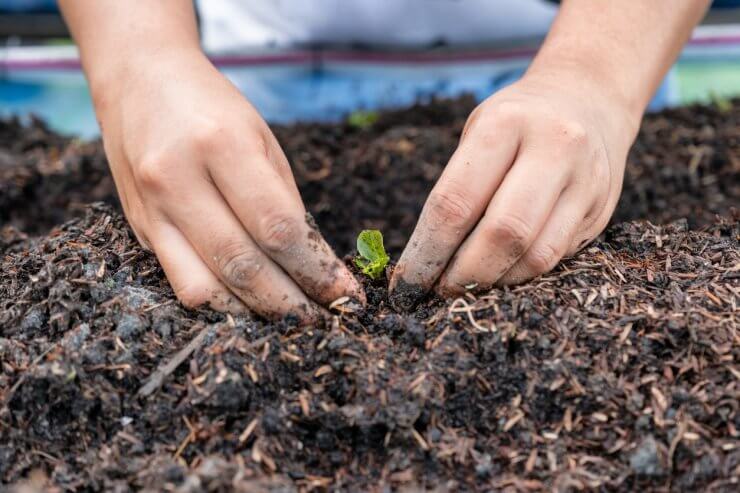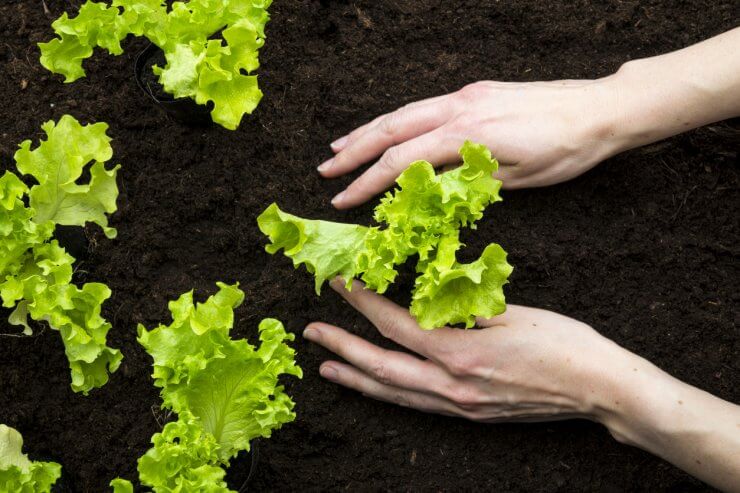
Gardener planting lettuce seedling in ground
Can you grow lettuce from seed? Yes. Should you? Yes. Lettuce is a shallow-rooted plant, and it can be a little fussy come transplant time. That being said, you can still start seeds indoors and transplant your seedlings after the last hard frost. Just be very gentle with them and be prepared to lose a few in the transplanting process.
Established seedlings can grow well, as long as you don’t damage their shallow root system. The less you handle your seedlings, the better. And if you don’t always have good luck with direct seeding in the ground, or you have a shorter growing season, then starting seedlings early is the way to go.
It’s also possible to grow lettuce from cuttings, but there are easier ways to get a more bountiful harvest. Let’s take a look at each of these growing approaches.
Seed Planting Process
Direct seeding is really the preferred way to go with lettuce. Seeds can germinate in as little as two days, and seedlings may emerge in as little as a week. It all depends on the soil temperature. Lettuce is a cool-weather crop; the seeds prefer a germination temperature range between 40 and 85 degrees F, although some seeds will go dormant at high temperatures. It’s best to plant your seeds when temps are below 70 degrees F.
In early spring, as soon as you can work the soil, plant your lettuce seeds. If you want to give your seeds a little boost, prepare your planting area the fall before to make a fine seedbed by working in manure or compost.
In general, sow your seeds only 1/8-inch deep, an inch apart, in rows 12 to 18 inches apart. Your exact planting distance will, of course, depend on the cultivar you’re growing. When your plants form two or three true leaves (the very first two don’t count), thin your seedlings to about a foot apart for crisphead varieties, and 6 to 10 inches for other varieties. Check your seed packet for details.
If you’re not particular about having nice, straight rows and you’re growing looseleaf lettuce, you can broadcast the seed and start yourself a lettuce patch. This is a delightfully ornamental way to grow looseleaf lettuce, especially if you’re growing several different varieties. It makes for a great color burst for your garden, not to mention colorful, delicious salads!
Growing Seedlings

Gardener planting lettuce seedlings
If you need to get a jump on your growing season, you can start your lettuce seeds indoors and transplant them after the last frost. You can also get seedlings from a local nursery, community farm, or gardening friend.
Be sure to harden off your seedlings before you transplant them. Put them outside in a sheltered area, out of the direct sun, for increasingly longer times each day for a week, bringing them back in at night. That helps the plant cells grow stronger, and your seedlings are more likely to survive the transplant process. Going straight from seed tray indoors to garden bed outdoors could shock your plants.
Growing from Cuttings
You can’t really grow lettuce from leaf cuttings; the leaves won’t generate new rootlets. But what you can do is regrow lettuce from harvested heads, if you want to. Or even a head from the market.
Now, if you’re already putting in the work of growing your own lettuce, you don’t really need to do this. You’re much better off doing successive plantings over the season so you have plenty of lettuce to harvest. But if you want to try regrowing, say, a harvested head of Romaine—or a head you bought at the market—it’s doable. You’ll need a section of the head about 3 inches high. Put it in water in a well-lit area and change the water frequently. After a few weeks, you should see some new root growth.
Is that worth the time and attention it will take to regrow some Romaine? If you need to, it is. If you have garden space and the time to give it the attention it needs, you’re probably better off doing succession planting every two to three weeks.
Cut-and-come-again
One of the easiest ways to prolong your lettuce harvest beyond multiple seeding sessions is to do what’s called cut-and-come-again harvesting. Think of it as regrowing your lettuce, but without the fuss of having to root it in your kitchen window. Just harvest the leaves you need as the plant is growing, and come back for more when you’re ready. This is an extremely popular harvesting method, especially for looseleaf lettuce. You can pick just enough for your salad, and leave the rest of the lettuce fresh on the plant!
Have you tried growing lettuce from seeds, seedlings, or cuttings? Which method do you prefer—and why? Have you tried cut-and-come-again harvesting to make your lettuce last longer? Please share your experiences with us.


 Previous
Previous


Could you please provide more details re growing from seeds in pots? How big/deep should the pots be? Potting soil? Not enough info in this article, sorry!
I always seed my lettuce. You’re right, transplanting is risky! I always use the Cut and Come-Again method. I can get three or more harvests from a batch of lettuce. I’ve grown it in-ground, but I really prefer to grow it in containers. I think it’s much less vulnerable to slugs, too. Tm.